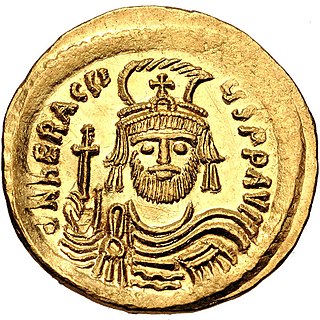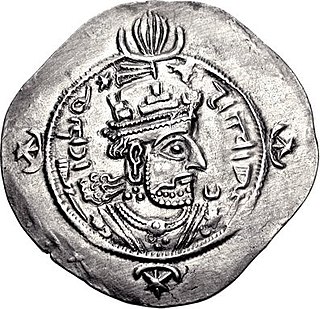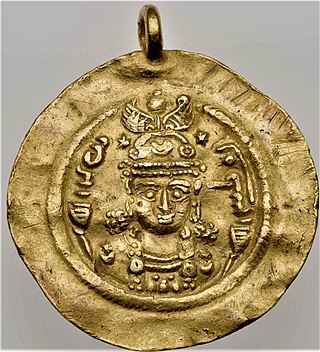
Heraclius was Eastern Roman emperor from 610 to 641. His rise to power began in 608, when he and his father, Heraclius the Elder, the exarch of Africa, led a revolt against the unpopular usurper Phocas.

Year 630 (DCXXX) was a common year starting on Monday of the Julian calendar. The denomination 630 for this year has been used since the early medieval period, when the Anno Domini calendar era became the prevalent method in Europe for naming years.

Kavad II was the Sasanian King of Kings of Iran briefly in 628.

Khosrow II, also known as Khosrow Parviz, is considered to be the last great Sasanian king (shah) of Iran, ruling from 590 to 628, with an interruption of one year.

Hormizd IV was the Sasanian King of Kings of Iran from 579 to 590. He was the son and successor of Khosrow I and his mother was a Khazar princess.

Shahrbaraz, was shah (king) of the Sasanian Empire from 27 April 630 to 9 June 630. He usurped the throne from Ardashir III, and was killed by Iranian nobles after forty days. Before usurping the Sasanian throne he was a spahbed (general) under Khosrow II (590–628). He is furthermore noted for his important role during the climactic Byzantine–Sasanian War of 602–628, and the events that followed afterwards.

Boran was Sasanian queen of Iran from 630 to 632, with an interruption of some months. She was the daughter of king Khosrow II and the Byzantine princess Maria. She is the second of only three women to rule in Iranian history, the others being Musa of Parthia, and Boran's sister Azarmidokht.

Rostam Farrokhzād was an Iranian dynast from the Ispahbudhan family, who served as the spahbed of the northwestern quarter (kust) of Adurbadagan during the reign of Boran and Yazdegerd III. Rostam is remembered as a historical figure, a character in the Persian epic poem Shahnameh, and as a touchstone of most Iranian nationalists.

The Sasanian or Sassanid Empire, officially known as Eranshahr was the last Iranian empire before the early Muslim conquests of the 7th–8th centuries AD. Named after the House of Sasan, it endured for over four centuries, from 224 to 651 AD, making it the longest-lived Persian imperial dynasty. The Sasanian Empire succeeded the Parthian Empire, and re-established the Persians as a major power in late antiquity alongside its neighbouring arch-rival, the Roman Empire.
Shahen or Shahin was a senior Sassanid Persian general (spahbed) during the reign of Khosrow II (590–628). He was a member of the House of Suren.

The Battle of Antioch took place in 613 outside Antioch, Turkey between a Byzantine army led by Emperor Heraclius and a Persian Sassanid army under Generals (spahbed) Shahin and Shahrbaraz as part of the Byzantine–Sassanid War of 602–628. The victorious Persians were able to maintain a hold on the recently taken Byzantine territory. The victory paved the way for a further Sasanian advance into the Levant and Anatolia.
Varaztirots II Bagratuni was an Armenian nakharar from the Bagratuni family, the son of Smbat IV Bagratuni. He was marzpan of Armenia c. 628, fled to the Byzantine Empire soon thereafter and was exiled for several years to Africa for his participation in a plot against Heraclius. On his return c. 645/6, he was named curopalates and presiding prince of Armenia, but died before being formally invested.

The Battle of al-Qadisiyyah was an armed conflict which took place in 636 CE between the Rashidun Caliphate and the Sasanian Empire. It occurred during the early Muslim conquests and marked a decisive victory for the Rashidun army during the Muslim conquest of Persia.

The Byzantine–Sasanian War of 602–628 was the final and most devastating of the series of wars fought between the Byzantine / Roman Empire and the Sasanian Empire of Iran. The previous war between the two powers had ended in 591 after Emperor Maurice helped the Sasanian king Khosrow II regain his throne. In 602 Maurice was murdered by his political rival Phocas. Khosrow declared war, ostensibly to avenge the death of the deposed emperor Maurice. This became a decades-long conflict, the longest war in the series, and was fought throughout the Middle East: in Egypt, the Levant, Mesopotamia, the Caucasus, Anatolia, Armenia, the Aegean Sea and before the walls of Constantinople itself.

Farrukh Hormizd or Farrokh Hormizd, also known as Hormizd V, was an Iranian prince, who was one of the leading figures in Sasanian Iran in the early 7th-century. He served as the military commander (spahbed) of northern Iran. He later came in conflict with the Iranian nobility, "dividing the resources of the country". He was later killed by Siyavakhsh in a palace plot on the orders of Azarmidokht after he proposed to her in an attempt to usurp the Sasanian throne. He had two children, Rostam Farrokhzad and Farrukhzad.
The siege of Ctesiphon took place on 27 April 629 between the forces of Shahrbaraz and Ardashir III. Shahrbaraz managed to capture Ctesiphon with a small force, revealing to all the weakness of the Sasanian Empire.
The Sasanian civil war of 628–632, also known as the Sasanian Interregnum was a conflict that broke out after the execution of the Sasanian king Khosrau II between the nobles of different factions, notably the Parthian (Pahlav) faction, the Persian (Parsig) faction, the Nimruzi faction, and the faction of general Shahrbaraz. Rapid turnover of rulers and increasing provincial landholder power further diminished the empire. Over a period of 4 years and 14 successive kings, the Sasanian Empire weakened considerably, and the power of the central authority passed into the hands of its generals, contributing to its fall.

Izadgushasp, known in Byzantine sources as Isdigousnas Zikh, was an Iranian nobleman from the House of Mihran, who served as one of Khosrow I's viziers.
Yazdin was an influential Iranian aristocrat, who served as the financial minister of the Sasanian king Khosrow II.

Dastagird, was an ancient Sasanian city in present-day Iraq, and was close to its capital, Ctesiphon.














